Manchester–Boston Regional Airport
Coordinates: 42°55′57″N 071°26′08″W / 42.93250°N 71.43556°W
| Manchester–Boston Regional Airport | |||||||||||||||
|---|---|---|---|---|---|---|---|---|---|---|---|---|---|---|---|
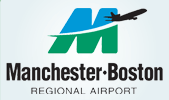 | |||||||||||||||
 Air photo taken 11 April 1998 | |||||||||||||||
|
IATA: MHT – ICAO: KMHT – FAA LID: MHT 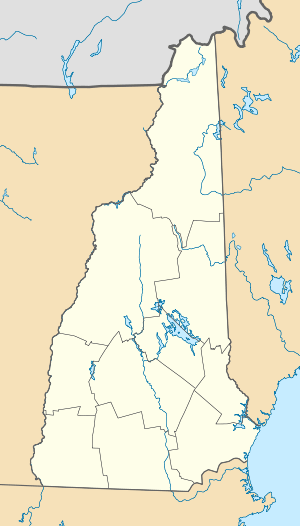 MHT | |||||||||||||||
| Summary | |||||||||||||||
| Airport type | Public | ||||||||||||||
| Owner | City of Manchester | ||||||||||||||
| Serves | Manchester, New Hampshire | ||||||||||||||
| Location | Manchester and Londonderry, New Hampshire | ||||||||||||||
| Hub for | Wiggins Airways | ||||||||||||||
| Elevation AMSL | 266 ft / 81 m | ||||||||||||||
| Website |
www | ||||||||||||||
| Runways | |||||||||||||||
| |||||||||||||||
| Statistics (2007, 2010) | |||||||||||||||
| |||||||||||||||
Manchester–Boston Regional Airport (IATA: MHT, ICAO: KMHT, FAA LID: MHT), commonly referred to as Manchester Airport, is a public airport 3 miles (5 km) south of the central business district of Manchester, New Hampshire,[1] on the border of Hillsborough and Rockingham counties. The airport lies in two communities, Manchester and Londonderry.
Founded in 1927, it moved more than 1 million passengers in a year for the first time in 1997. It handled 3.72 million passengers in 2008, down from its all-time high of 4.33 million in 2005. It remains New England's fourth-largest airport by passenger volume, behind Boston Logan in Massachusetts, Bradley International in Connecticut, and T. F. Green in Rhode Island.
The facility was known as Manchester Airport until April 18, 2006, when it added "Boston Regional" to advertise its proximity to Boston, about 50 miles (80 km) to the south.
Certified for Cat III B Instrument Landing operations, the airport has a reputation for never surrendering to bad weather. The airport has closed only once, when the national airspace was shut down for two days following the September 11 terrorist attacks, and all American airports were required to close.[2]
It is home to the New Hampshire Aviation Museum, built around an Art Deco control tower and terminal opened in 1938.
Use
Municipalities within the Boston Metropolitan Area, in partnership with their state governments in Massachusetts and New Hampshire, decided to make Manchester and T. F. Green alternatives to Boston's Logan Airport in order to avoid having to build a new airport.
Manchester–Boston is New England's third-largest cargo airport. Only Connecticut's Bradley International, which is a hub for UPS Airlines, and Logan exceed it in terms of cargo handled. In 2005, the airport processed 150 million pounds of freight. Most of this was carried aboard aircraft flown by FedEx, UPS, and DHL. All three serve Manchester with large, cargo-specific jets, including the Airbus A300, DC-10, and MD-11 by FedEx and UPS.
UPS uses Manchester to "feed" the rest of northern New England by contracting with Wiggins Airways,[3] which flies smaller prop-driven planes to places like Portland, Augusta, Bangor, Presque Isle, Rutland, and other communities. To handle this "regional sort", UPS built a sorting facility where packages coming in from the company's Louisville hub are redistributed to trucks or to the Wiggins feeder aircraft. FedEx previously used Manchester as a regional sorting station as well, but now supports the northern New England destinations via direct flights from Memphis, Tennessee to Portland and Burlington. A contract with the Postal Service fills the FedEx jets (coming from hubs in Memphis and Indianapolis) with mail in addition to the typical assortment of express and overnight packages. DHL used to operate a 727-200 on a Wilmington, Ohio-Allentown, Pennsylvania-Manchester-Wilmington routing, but that service has since ceased.
Facility and operations
Manchester Airport covers an area of 1,500 acres (610 ha) which contains two asphalt runways: Runway 17/35 measuring 9,250 x 150 ft (2,819 x 46 m) and Runway 6/24 measuring 7,650 x 150 ft (2,332 x 46 m).[1]
For the 12-month period ending January 31, 2007, the airport had 93,138 aircraft operations, an average of 255 per day: 41% scheduled commercial, 31% air taxi, 27% general aviation, and 1% military. There are 100 aircraft based at this airport: 75% single engine, 15% multi-engine and 10% jet aircraft.[1]
History
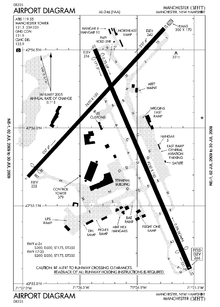
The Manchester airport was founded in June 1927, when the city's Board of Mayor and Aldermen put $15,000 towards the project. By October, a board of aviation had been founded and ground was broken at an 84-acre (34 ha) site near Pine Island Pond. It took only a month for two 1,800-foot (550 m) runways to be constructed. The board of aviation convinced George G. "Scotty" Wilson, a barnstormer operating out of Boston, to move to New Hampshire and start Manchester's first flying service. After the formation of Northeast Airways at the site in 1933, the first passenger terminal was built.
The current Manchester airport began to take shape as a joint civil-military facility in the 1960s. The first major development at MHT was the construction of a new civilian terminal, and the first modern air traffic control tower in New Hampshire, in 1961. Roscoe A. Ammon, a successful businessman, donated $500,000 for the construction of the new civilian air terminal. Unfortunately, Roscoe Ammon died of cancer less than two weeks before the terminal was opened, and thus missed the opportunity to see the product of his generous donation. A new passenger terminal was later built in 1994. In 1966, the Air Force removed its remaining forces and closed Grenier AFB, leaving the airport open for expansion. In 1978 the airfield was renamed Manchester Airport.
Throughout the 1960s and 1970s, the airport was served by Northeast Airlines with the CV-240, DC-9, and FH-227. Delta Air Lines absorbed Northeast in 1972 and continued to serve the airport with the DC-9 until 1978, then 727-200s until 1980 when it discontinued service at Manchester. In the mid-1980s, airlines once again started offering jet service out of Manchester. United Airlines inaugurated service at Manchester in 1983 with two daily flights to Chicago-O'Hare. This was part of their 50 States campaign, which positioned United as the only carrier to serve all 50 states with mainline service. The Boeing 727 and Boeing 737 were initially used on the Chicago flights, which would often make intermediate stops in cities like Providence, Albany, Syracuse, and Burlington, to pick up or drop off passengers. Manchester was also a "tag-on" for United flights heading from Bangor and Portland, Maine, to Chicago, but the carrier no longer serves either city with mainline aircraft.
In the early 1990s, United Airlines began flights between Manchester and Washington Dulles International Airport near Washington, D.C. But creation of a north-south hub at Dulles did not work for United, and heavy competition in this market led to a quick exit. The Boeing 737 was used for this short-lived service, which comprised about four daily circuits between the two airports. US Airways started service at Manchester in early 1986, by connecting their hubs at Pittsburgh and Philadelphia. The carrier used the DC-9, BAC 111, and 737-200 aircraft. Both carriers expanded service at Manchester over the years with larger planes and more flights. United now runs a strict non-stop schedule to and from Chicago with no intermediate stops or tag-ons. The 757 has been used by both United and US Airways at Manchester, which stands as the largest passenger-carrying plane to serve the airport in scheduled service. The Airbus A320 series of aircraft is also commonly used by United, Northwest Airlines (merged with Delta Air Lines), and occasionally by US Airways. In April 2010, Delta enhanced service to Manchester; it dropped its daily CRJ-700 service to Atlanta and replaced the aircraft with an MD-88 with seating for 149. Delta also switched all its Delta Connection service to Detroit with mainline service on DC-9's. Delta and Southwest are the only airlines serving Manchester with all mainline jets, Southwest with the Boeing 737.
Expansion
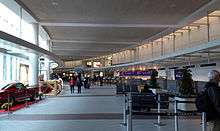
In 1992, a long-term expansion and improvement plan started to take shape. Two years later, a new 158,000-square-foot (14,700 m2) terminal designed by HNTB and Lavallee Brensinger opened, providing ample room for larger jets.[4] The airport continued to expand, opening a new parking garage and parking lots in the next years, as well as working to reconstruct the runways and taxiways. In 1998, these expansions paid off, with MetroJet, Northwest, and Southwest all beginning service. The airport has prospered from the "Southwest Effect", in which competing airlines increase service and decrease fares to compete with the low-cost carrier. Throughout the 1990s, Manchester outpaced almost every other similarly-sized airport in terms of passenger growth. In 2003, Runway 17/35 was extended from 7,001 feet (2,134 m) to 9,250 feet (2,820 m), allowing non-stop service to Las Vegas.
In April 2006, the aldermen of the city of Manchester voted to change the name of the airport to "Manchester–Boston Regional Airport" in an effort to increase its visibility to travelers around the country.[5]
Airlines and destinations
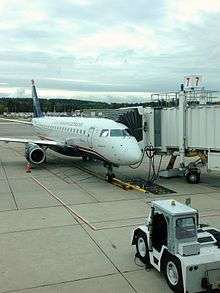
Passenger
| Airlines | Destinations |
|---|---|
| American Eagle | Charlotte, Philadelphia, Washington–National |
| Delta Air Lines | Atlanta Seasonal: Detroit |
| Delta Connection | Detroit, New York–LaGuardia |
| Southwest Airlines | Baltimore, Chicago–Midway, Orlando, Tampa Seasonal: Fort Lauderdale, Las Vegas |
| United Express | Chicago–O'Hare, Newark |
Cargo
| Airlines | Destinations |
|---|---|
| FedEx Express | Memphis, Buffalo Seasonal: Hartford, Indianapolis |
| UPS Airlines | Hartford, Louisville, Philadelphia, Syracuse |
| FedEx Feeder operated by Wiggins Airways | Bangor, Barre/Montpelier, Burlington (VT), Hartford, Portland (ME), Presque Isle, Rockland, Rutland, Waterville (ME) |
Statistics
Top domestic destinations
| Rank | Airport | Passengers | Carriers |
|---|---|---|---|
| 1 | Baltimore, Maryland | 269,000 | Southwest |
| 2 | Chicago (Midway), Illinois | 120,000 | Southwest |
| 3 | Philadelphia, Pennsylvania | 116,000 | US Airways |
| 4 | Orlando, Florida | 105,000 | Southwest |
| 5 | Tampa, Florida | 62,000 | Southwest |
| 6 | Washington (National), D.C. | 57,000 | US Airways |
| 7 | Detroit, Michigan | 56,000 | Delta |
| 8 | Atlanta, Georgia | 47,000 | Delta |
| 9 | Charlotte, North Carolina | 45,000 | US Airways |
| 10 | Newark, New Jersey | 44,000 | United |
Annual traffic
| Year | Passengers | Year | Passengers | Year | Passengers |
|---|---|---|---|---|---|
| 2010 | 2,814,432 | 2000 | 3,169,301 | ||
| 2009 | 3,181,249 | ||||
| 2008 | 3,716,393 | ||||
| 2007 | 3,892,630 | ||||
| 2006 | 3,896,532 | ||||
| 2005 | 4,329,478 | ||||
| 2014 | 2,095,674 | 2004 | 4,003,307 | ||
| 2013 | 2,422,102 | 2003 | 3,601,661 | ||
| 2012 | 2,452,064 | 2002 | 3,366,834 | ||
| 2011 | 2,710,747 | 2001 | 3,233,555 |
Ground transport
Highway access
In 2007, construction began on Raymond Wieczorek Drive (then known as Manchester Airport Access Road), an expressway connection from the F.E. Everett Turnpike.[8] Before this project, access to the airport was limited to local roads off Interstate 293/NH Route 101. The access road opened on November 10, 2011, connecting the airport and NH Route 3A in Litchfield with the Everett Turnpike and U.S. Route 3 in Bedford.[9]
Manchester Shuttle
From November 13, 2006, to June 30, 2008, the airport operated a shuttle bus — free to ticketed passengers — that ran every two hours, 24 hours a day, to the Anderson Regional Transportation Center in Woburn, Massachusetts (45 minutes), on to the Sullivan Square subway station in Boston (75 minutes), and back to the airport via Woburn.[10] The free service shut down after a private company, Flight Line Inc., began operating a paid service along similar routes on July 1, 2008. Flight Line offers hourly service between the airport, several points in northern Massachusetts, and the city of Boston for $39 each way. Reservations are required.[11]
Greyhound Lines
Greyhound buses offer three trips daily from Manchester Airport on its Boston-Montreal service. Buses serve Concord, Hanover, White River Junction, Montpelier, Burlington, Saint-Jean-sur-Richelieu, and Montreal when going northbound. They serve South Station and Logan on the southbound trips.
Local bus service
The Manchester Transit Authority provides hourly bus service between the passenger terminal and downtown Manchester.
MBTA commuter and Pan Am freight rail
The Massachusetts Bay Transportation Authority has proposed to extend the Lowell Line of its commuter rail system to Manchester, along with using the former Manchester and Lawrence branch, including Manchester Airport. However, this only remains a proposal, and no funds have yet been allocated for the project.
The New Hampshire State Rail Plan of 2012 stated that freight could also be viable on the M&L, perhaps opening up more freight opportunities for the airport.
Law enforcement / security
The Londonderry Police Department is responsible for law enforcement and security operations at the airport terminal. The Rockingham County Sheriff's Department was responsible for law enforcement operations at the airport until 2006 when the Londonderry Police Department was awarded the new security contract.
References
- 1 2 3 4 FAA Airport Master Record for MHT (Form 5010 PDF), effective 2007-07-05
- ↑ Edward W. Browder, Jr. and Maurice B. Quirin, Manchester's Airport: Flying Through Time, pp. 329-330. ISBN 0-9721489-9-X
- ↑ "Wiggins Airways' Aircraft Flight Operations". Retrieved 2008-08-09.
- ↑ Lavallee Brensinger - Manchester/Boston Regional Airport
- ↑ "04/18/2006 Board of Mayor and Aldermen Meeting Minutes" (PDF). Retrieved 20 September 2014.
- ↑ "Manchester, NH: Manchester-Boston Regional (MHT)". Bureau of Transportation Statistics. January 2016. Retrieved February 1, 2016.
- ↑ About (Passenger & Cargo Statistics). Retrieved on Apr 3, 2015.
- ↑ "Manchester Airport Access Road Project 11512 - Overall Plan" (PDF). NH Department of Transportation.
- ↑ Nashua Telegraph article on opening
- ↑ Airport Announces Free Bus Service Between Woburn and Boston For Ticketed Passengers
- ↑ Manchester Shuttle Pilot Program Proves Successful! Private Ground Transportation Company to Offer High Frequency, Affordable Service to Northern Massachusetts and Boston
External links
- Official website
- Historic American Engineering Record (HAER) No. NH-32, "Manchester Airport, South of downtown Manchester, east of Route 3A & Pine Island Pond, Manchester, Hillsborough County, NH"
- FAA Airport Diagram (PDF), effective January 7, 2016
- Resources for this airport:
- AirNav airport information for KMHT
- ASN accident history for MHT
- FlightAware airport information and live flight tracker
- NOAA/NWS latest weather observations
- SkyVector aeronautical chart for KMHT
- FAA current MHT delay information
| ||||||||||||||||||||||||||||||||